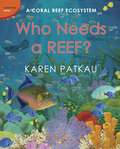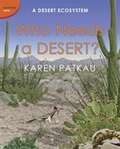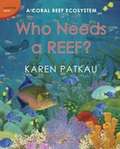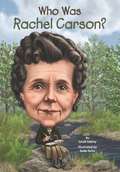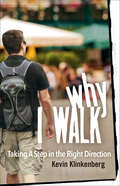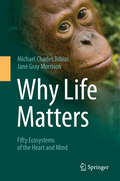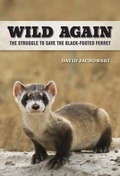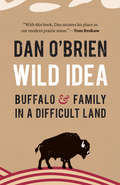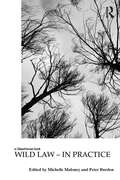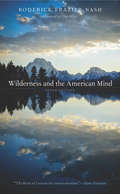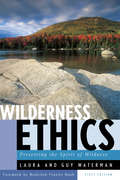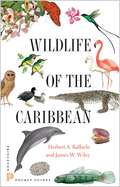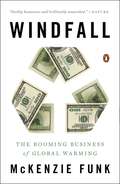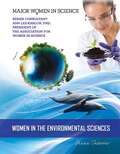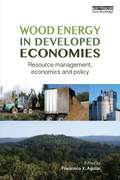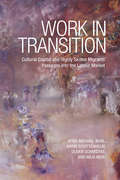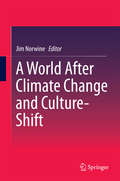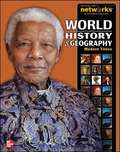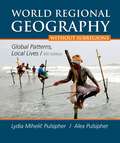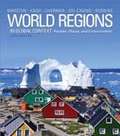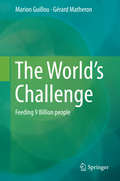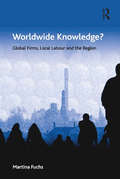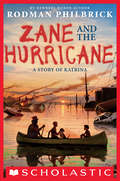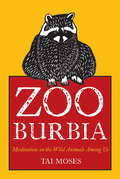- Table View
- List View
Who Needs a Reef?: A Coral Reef Ecosystem (Ecosystem Series)
by Karen PatkauKaren Patkau takes readers on an amazing voyage of discovery to find out • How coral reefs form • Why coral reefs bustle and teem with life • Why there are more kinds of living things on coral reefs than anywhere else in the sea • What the types of hard corals are • Which plants and animals attach themselves to coral reefs • How coral reefs protect shorelines • How coral reefs help develop natural harbors and beaches • Where the coral reef areas of the world are • Why we need coral reefs
Who Needs A Desert?: A Desert Ecosystem
by Karen PatkauThe Ecosystem Series explores jungle, icebergs, swamps, deserts, prairies and reefs. In Who Needs A Desert? Karen Patkau takes readers on an amazing voyage of discovery to find out how deserts are formed and where in the world they are most often found. Not only this, but readers will discover how plants and animals adapt to the severe environment, what wildlife thrives there, which plants bloom under the blazing sun and how desert plants and animals get energy and food.
Who Needs A Reef?: A Coral Reef Ecosystem (Ecosystem)
by Karen PatkauWho Needs a Reef A Coral Ecosystem
Who Was Rachel Carson? (Who was?)
by Dede Putra Sarah Fabiny Nancy HarrisonThough she grew up in rural Pennsylvania, Rachel Carson dreamed of the sea. In 1936 she began work with the Bureau of Fisheries and soon after published Under the Sea Wind, her first of many nature books. Her 1962 bestseller, Silent Spring, sent shockwaves through the country and warned of the dangers of DDT and other pesticides. A pioneering environmentalist, Rachel Carson helped awaken the global consciousness for conservation and preservation.
Why I Walk: Taking A Step in the Right Direction
by Kevin KlinkenbergA recent survey shows that members of Gen Y are walking 37 percent more than a decade ago, biking 122 percent more and taking public transit 100 percent more. Still, the legacy of the car culture persists. Raised on the notion that driving equals freedom, too many of us just don't realize that a personally rewarding alternative even exists.Just over three years ago, author Kevin Klinkenberg moved to Savannah, Georgia, from Kansas City, Missouri. In large part, he chose his new home because he was seeking a truly walkable place to live. In Why I Walk, Kevin goes beyond the typical arguments against suburbia, showing how walking on a daily basis actively benefits: His finances His sense of personal freedom His social life His healthThe majority of us still cling to the belief that a house in the suburbs, with good schools, low crime, and easy parking is the American Dream. By focusing directly on the real, measurable advantages of choosing to be a pedestrian, Why I Walk makes a convincing case for ending our love affair with the automobile. This highly readable, first-person narrative handily provides the answer to the pressing question, "Why do I walk?"Why? Because getting there is twice the fun.Kevin Klinkenberg is the principal designer at K2 Urban Design. For more than two decades he has been working to create sustainable, sociable environments and walkable communities in cooperation with developers, cities, nonprofits, and public agencies.
Why Life Matters
by Michael Charles Tobias Jane Gray MorrisonDr. Michael Charles Tobias and Jane Gray Morrison are world-renowned ecological philosophers and activists, interdisciplinary social and environmental scientists and broad-ranging, deeply committed humanists. This collection of fifty essays and interviews comprises an invigorating, outspoken, provocative and eloquent overview of the ecological humanities in one highly accessible volume. The components of this collection were published in the authors' "Green Conversations" blog series, and pieces in the Eco News Network from 2011 to 2013 and feature luminaries from Jane Goodall to Ted Turner to the Secretary of the Smithsonian Institution to the former head of the UN Convention on Biological Diversity. Stunning color photographs captured by the authors and contributors make Why Life Matters: Fifty Ecosystems of the Heart and Mind a feast for the eyes as well as the mind and soul. Ethics, science, technology, ecological literacy, grass-roots renaissance thinkers, conservation innovation from the U. S. to the U. K. ; from India to Ecuador; from Bhutan to Haiti; from across Africa, the Neo-Tropics, Central Asia and Japan, to Rio, Shanghai and Manhattan - this humanistic ode to the future of life on earth is a relevant and resonating read. Michael Tobias and Jane Gray Morrison, partners who between them have authored some 50 books and written, directed and produced some 170 films, a prolific body of work that has been read, translated and/or broadcast around the world, have been married for more than a quarter-of-a-century. Their field research across the disciplines of comparative literature, anthropology, the history of science and philosophy, ecology and ethics, in over 80 countries, has served as a telling example of what two people - deeply in love with one another - can accomplish in spreading that same unconditional love to others - of all species.
Wild Again
by David S. JachowskiThis engaging personal account of one of America's most contested wildlife conservation campaigns has as its central character the black-footed ferret. Once feared extinct, and still one of North America's rarest mammals, the black-footed ferret exemplifies the ecological, social, and political challenges of conservation in the West, including the risks involved with intensive captive breeding and reintroduction to natural habitat. David Jachowski draws on more than a decade of experience working to save the ferret. His unique perspective and informative anecdotes reveal the scientific and human aspects of conservation as well as the immense dedication required to protect a species on the edge of extinction. By telling one story of conservation biology in practice--its routine work, triumphs, challenges, and inevitable conflicts--this book gives readers a greater understanding of the conservation ethic that emerged on the Great Plains as part of one of the most remarkable recovery efforts in the history of the Endangered Species Act.
Wild Idea: Buffalo and Family in a Difficult Land
by Dan O'BrienFor more than forty years the prairies of South Dakota have been Dan O’Brien’s home. Working as a writer and an endangered-species biologist, he became convinced that returning grass-fed, free-roaming buffalo to the grasslands of the northern plains would return natural balance to the region and reestablish the undulating prairie lost through poor land management and overzealous farming. In 1998 he bought his first buffalo and began the task of converting a little cattle ranch into an ethically run buffalo ranch. Wild Idea is a book about how good food choices can influence federal policies and the integrity of our food system, and about the dignity and strength of a legendary American animal. It is also a book about people: the daughter coming to womanhood in a hard landscape, the friend and ranch hand who suffers great tragedy, the venture capitalist who sees hope and opportunity in a struggling buffalo business, and the husband and wife behind the ranch who struggle daily, wondering if what they are doing will ever be enough to make a difference. At its center, Wild Idea is about a family and the people and animals that surround them—all trying to build a healthy life in a big, beautiful, and sometimes dangerous land.
Wild Law - In Practice (Law, Justice and Ecology #4)
by Peter Burdon Michelle MaloneyWild Law - In Practice aims to facilitate the transition of Earth Jurisprudence from theory into practice. Earth Jurisprudence is an emerging philosophy of law, coined by cultural historian and geologian Thomas Berry. It seeks to analyse the contribution of law in constructing, maintaining and perpetuating anthropocentrism and addresses the ways in which this orientation can be undermined and ultimately eliminated. In place of anthropocentrism, Earth Jurisprudence advocates an interpretation of law based on the ecocentric concept of an Earth community that includes both human and nonhuman entities. Addressing topics that include a critique of the effectiveness of environmental law in protecting the environment, developments in domestic/constitutional law recognising the rights of nature, and the regulation of sustainability, Wild Law - In Practice is the first book to focus specifically on the practical legal implications of Earth Jurisprudence.
Wilderness and the American Mind
by Roderick Frazier Nash Char MillerRoderick Nash's classic study of changing attitudes toward wilderness during American history, as well as the origins of the environmental and conservation movements, has received wide acclaim since its initial publication in 1967. The Los Angeles Times listed it among the one hundred most influential books published in the last quarter century, Outside Magazine included it in a survey of "books that changed our world," and it has been called the "Book of Genesis for environmentalists." For the fifth edition, Nash has written a new preface and epilogue that brings Wilderness and the American Mind into dialogue with contemporary debates about wilderness. Char Miller's foreword provides a twenty-first-century perspective on how the environmental movement has changed, including the ways in which contemporary scholars are reimagining the dynamic relationship between the natural world and the built environment.
Wilderness Ethics: Preserving the Spirit of Wildness
by Laura Waterman Guy WatermanThe classic environmental call to action 2014 marks the 50th anniversary of the passing of the Wilderness Act--the landmark piece of legislation to set aside and protect pristine parts of the American landscape. This anniversary edition of Wilderness Ethics should help put the many issues surrounding wilderness in focus.
Wildlife of the Caribbean (Princeton Pocket Guides)
by Herbert Raffaele James WileyThis is the first comprehensive illustrated guide to the natural world of the Caribbean islands. It contains 600 vivid color images featuring 451 species of plants, birds, mammals, fish, seashells, and much more. While the guide primarily looks at the most conspicuous and widespread species among the islands, it also includes rarely seen creatures―such as the Rhinoceros Iguana and Cuban Solenodon―giving readers a special sense of the region's diverse wildlife. <p><p> Each species is represented by one or more color photos or illustrations; details regarding its identification, status, and distribution; and interesting aspects of its life history or relationship to humans. In addition, an introductory section focuses on the unique characteristics of the Caribbean’s fauna and flora, the threats faced by both, and some of the steps being taken to sustain the area’s extraordinary natural heritage.
Windfall
by Mckenzie FunkA fascinating investigation into how people around the globe are cashing in on a warming world McKenzie Funk has spent the last six years reporting around the world on how we are preparing for a warmer planet. Funk shows us that the best way to understand the catastrophe of global warming is to see it through the eyes of those who see it most clearly--as a market opportunity. Global warming's physical impacts can be separated into three broad categories: melt, drought, and deluge. Funk travels to two dozen countries to profile entrepreneurial people who see in each of these forces a potential windfall. The melt is a boon for newly arable, mineral-rich regions of the Arctic, such as Greenland--and for the surprising kings of the manmade snow trade, the Israelis. The process of desalination, vital to Israel's survival, can produce a snowlike by-product that alpine countries use to prolong their ski season. Drought creates opportunities for private firefighters working for insurance companies in California as well as for fund managers backing south Sudanese warlords who control local farmland. As droughts raise food prices globally, there is no more precious asset. The deluge--the rising seas, surging rivers, and superstorms that will threaten island nations and coastal cities--has been our most distant concern, but after Hurricane Sandy and failure after failure to cut global carbon emissions, it is not so distant. For Dutch architects designing floating cities and American scientists patenting hurricane defenses, the race is on. For low-lying countries like Bangladesh, the coming deluge presents an existential threat. Funk visits the front lines of the melt, the drought, and the deluge to make a human accounting of the booming business of global warming. By letting climate change continue unchecked, we are choosing to adapt to a warming world. Containing the resulting surge will be big business; some will benefit, but much of the planet will suffer. McKenzie Funk has investigated both sides, and what he has found will shock us all. To understand how the world is preparing to warm, Windfall follows the money.
Women in the Environmental Sciences (Major Women in Science #10)
by Shaina IndovinoWomen have made major contributions to science throughout history, including in the environmental sciences. Learn about the lives of some of the most amazing women in environmental science, from Rachel Carson to Lena Ma, as well as their exciting and important work. Discover what it takes to work in the environmental sciences. Find out about the opportunities for women in the field. Read Women in the Environmental Sciences to see if following in the footsteps of the many brilliant women who have made their mark in environmental science is something you want to do.
Wood Energy in Developed Economies: Resource Management, Economics and Policy
by Francisco X. AguilarThere has been a recent resurgence of interest in wood energy as part of a sustainable range of renewable energy options. This book addresses the current gap in the energy and public policy literature for a reference book that compiles the most-recent wood energy assessments, and evaluates current and potential future wood energy uses and the role for public policy to foster efficient use of the most-widely consumed renewable energy in the world. It brings together a group of expert authors covering topics from forest management, operations and engineering, to socio-economics and energy policy perspectives. It thus covers practical issues such as silviculture, harvesting, processing, comparative cost estimates, public policy tools and market effects. As such the book provides a comprehensive review of the complex dimensions of wood energy as well as practical guidance for professionals, researchers and advanced students. It will also provide invaluable guidance for economic development agencies, practitioners and policy-makers, when evaluating the impacts of wider wood energy adoption as part of a strategy for sustainable energy generation. The main focus is on industrialised production and developed economies, particularly the USA and Europe.
Work in Transition
by Anja Weiss Oliver Schmidtke Arnd-Michael Nohl Karin SchittenhelmDespite the fact that many countries target highly skilled migrants for recruitment in the global labour market, few of those migrants are able to take full advantage of their educational and professional qualifications in their new homes. Work in Transition examines this paradox, using extended narrative interviews that focus on the role that cultural capital plays in the labour market.Comparing the migrant experience in Germany, Canada, and Turkey, Work in Transition shows how migrants develop their cultural capital in order to enter the workforce, as well as how failure to leverage that capital can lead to permanent exclusion from professional positions. Exposing the mechanisms that drive inclusion and exclusion for migrants from a transatlantic comparative perspective, this book provides a unique analytical approach to an increasingly important global issue.
Working Childhoods
by Jane DysonWorking Childhoods draws upon research in the Indian Himalayas to provide a theoretically-informed account of children's lives in a remote part of the world. The book shows that children in their pre-teens and teens are lynchpins of the rural economy, spending hours each day herding cattle, collecting leaves, and juggling household tasks with schoolwork. Through documenting in painstaking detail children's stories, songs, friendships, fears and tribulations, the book offers a powerful account of youth agency and young people's rich relationship with the natural world. The 'environment' emerges not only as a crucial economic resource but also as a basis for developing gendered ideas of self. The book should be essential reading for anyone interested in better understanding childhood, youth, the environment, and development within and beyond India - including anthropologists, sociologists, geographers, development studies scholars, and South Asianists.
A World After Climate Change and Culture-Shift
by Jim NorwineIn this book, an international team of environmental and social scientists explain two powerful current change-engines and how their effects, and our responses to them, will transform Earth and humankind into the 22nd-century (c. 2100). This book begins by detailing the current state of knowledge about these two ongoing, accelerating and potentially world-transforming changes: climate change, in the form of global warming, and a profound emerging shift of normative cultural condition toward the assumptions and values often associated with so-called postmodernity, such as tolerance, diversity, self-referentiality, and dubiety replaced with certainty. Next, the contributors imagine, explain and debate the most likely consequent transformations of human and natural ecologies and economies that will take place by the end of the 21st-century. In 16 compellingly original, provocative and readable chapters, A World after Climate Change and Culture-Shift presents a one-of-a-kind vision of our current age as a "hinge" or axial century, one driven by the most radical combined change of nature and culture since the rise of agriculture at the end of the last Ice Age some 10 millennia ago. This book is highly recommended to scholars and students of the environmental and social sciences, as well as to all readers interested in how changes in nature and culture will work together to reshape our world and ourselves. "I cannot think of a book more geared to advancing the art and science of geography. " - Yi-Fu Tuan, J. K. Wright and Vilas Professor Emeritus of Geography, University of Wisconsin-Madison"Outstanding," "unique," and "exceptional timeliness of topic and ambition ofvision". - Richard Marston, University Distinguished Professor, Kansas State University; past president, Association of American Geographers
World History & Geography: Modern Times
by Jackson J. Spielvogel Jay MctigheBuilt on the principles of Understanding by Design, the streamlined student text includes core world history standards in a concise, accessible format.
World Regional Geography: Global Patterns, Local Lives (Without Subregions) (Sixth Edition)
by Lydia Mihelic Pulsipher Alex A. Pulsipher Conrad Mac" GoodwinThe main goal of this book is to make global patterns of trade and consumption meaningful for students by showing how these patterns affect not only world regions but also ordinary people at the local level.
World Regions in Global Context: Peoples, Places, and Environments (5th Edition)
by Sallie A. Marston Paul L. Knox Diana M. Liverman Vincent J. Del Casino Paul F. RobbinsThe author provides a framework for understanding the global connections that affect the dynamic and complex relationships between people and the worlds they inhabit.
The World's Challenge
by Marion Guillou Gérard MatheronIf a global population of 9 billion by 2050 is to be fed adequately, more food must be produced and this in keeping with increasingly stringent standards of quality and with respect for the environment. Not to mention the land that must be set aside for the production of energy resources, industrial goods, carbon storage and the protection of biodiversity.
Worldwide Knowledge?: Global Firms, Local Labour and the Region (Economic Geography Series)
by Martina FuchsPutting forward a comprehensive view of knowledge with a specific perspective on place and space, this book provides a new perspective on the globalisation of knowledge. Crossing disciplinary boundaries, the principal agenda of this volume is to open up a perspective ’beyond knowledge’ - i.e. beyond the interpretation of knowledge as scientific-technical knowledge. Author Martina Fuchs introduces further kinds of knowledge and interpretation which influence managements’ perception of globalisation and therefore the knowledge which is going global. She refers to knowledge in the sense of experiences, competencies in the production and labour process, as well as mutually shared mental constructs which are embedded in a context of understanding and interpretation. Exploring beyond the meaning of worldwide knowledge as general open access knowledge, this book also discusses barriers to knowledge, problems of transfer, and the influence of governance and control.
Zane and the Hurricane: A Story Of Katrina
by Rodman PhilbrickNewbery Honor author Rodman Philbrick presents a gripping yet poignant novel about a 12-year-old boy and his dog who become trapped in New Orleans during the horrors of Hurricane Katrina. <p><P> Zane Dupree is a charismatic 12-year-old boy of mixed race visiting a relative in New Orleans when Hurricane Katrina hits. Unexpectedly separated from all family, Zane and his dog experience the terror of Katrina's wind, rain, and horrific flooding. <P>Facing death, they are rescued from an attic air vent by a kind, elderly musician and a scrappy young girl--both African American. The chaos that ensues as storm water drowns the city, shelter and food vanish, and police contribute to a dangerous, frightening atmosphere, creates a page-turning tale that completely engrosses the reader. <p> Based on the facts of the worst hurricane disaster in U.S. history, Philbrick includes the lawlessness and lack of government support during the disaster as well as the generosity and courage of those who risked their lives and safety to help others. Here is an unforgettable novel of heroism in the face of truly challenging circumstances.
Zooburbia: Meditations on the Wild Animals Among Us
by Dave Buchen Tai MosesTo be alienated from animals is to live a life that is not quite whole, contends nature writer Tai Moses in Zooburbia: Meditations On The Wild Animals Among Us. Urban and suburban residents share their environment with many types of wildlife: squirrels, birds, spiders, and increasingly lizards, deer, and coyote. Many of us crave more contact with wild creatures, and recognize the small and large ways animals enrich our lives, yet don't notice the animals already around us.Zooburbia reveals the reverence that can be felt in the presence of animals and shows how that reverence connects us to a deeper, better part of ourselves. A lively blend of memoir, natural history, and mindfulness practices, Zooburbia makes the case for being mindful and compassionate stewards--and students--of the wildlife with whom we coexist. With lessons on industriousness, perseverance, presence, exuberance, gratitude, aging, how to let go, and much more, Tai's vignettes share the happy fact that none of us is alone and separate, and that our teachers are right in front of us. We need only go outdoors with our eyes and ears open to find a rapport with the animal kingdom. Zooburbia is a magnifying lens turned to our everyday environment, reminding us that we, as individuals and as a species, are not alone.Illustrated by Dave Buchen with original black and white wildlife linocuts.
